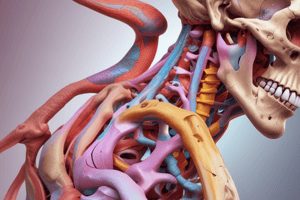Podcast
Questions and Answers
Paget disease is commonly found in patients under the age of 50.
Paget disease is commonly found in patients under the age of 50.
False (B)
Lytic lesions in Paget disease exhibit a flame or blade of grass shape on imaging.
Lytic lesions in Paget disease exhibit a flame or blade of grass shape on imaging.
True (A)
Sclerotic bone in Paget disease can be identified as an 'ivory vertebra' on imaging.
Sclerotic bone in Paget disease can be identified as an 'ivory vertebra' on imaging.
True (A)
A common initial symptom of Paget disease is sharp pain in the affected bones.
A common initial symptom of Paget disease is sharp pain in the affected bones.
Elevated ALP levels with normal calcium and phosphate levels are typical diagnostic findings in Paget disease.
Elevated ALP levels with normal calcium and phosphate levels are typical diagnostic findings in Paget disease.
Cranial nerve palsies can occur in Paget disease due to compression at neural foramina.
Cranial nerve palsies can occur in Paget disease due to compression at neural foramina.
High output cardiac failure is a common and typical presentation of Paget disease.
High output cardiac failure is a common and typical presentation of Paget disease.
Paget disease results in disordered bone structure, which is generally stronger than normal bone.
Paget disease results in disordered bone structure, which is generally stronger than normal bone.
Sarcomatous degeneration in Paget disease generally leads to a good prognosis.
Sarcomatous degeneration in Paget disease generally leads to a good prognosis.
Coarsening of the trabeculae and cortices is a hallmark observed in Paget disease radiological findings.
Coarsening of the trabeculae and cortices is a hallmark observed in Paget disease radiological findings.
Flashcards
Paget disease
Paget disease
A bone disease characterized by excessive bone breakdown and formation, leading to weakened and deformed bones.
Lytic phase of Paget disease
Lytic phase of Paget disease
The initial stage of Paget disease where bone breakdown predominates, creating lytic lesions.
Mixed phase of Paget disease
Mixed phase of Paget disease
The stage of Paget disease where both bone breakdown and formation occur simultaneously.
Sclerotic phase of Paget disease
Sclerotic phase of Paget disease
Signup and view all the flashcards
Tam O'Shanter sign
Tam O'Shanter sign
Signup and view all the flashcards
High output cardiac failure in Paget disease
High output cardiac failure in Paget disease
Signup and view all the flashcards
Bone scan in Paget disease
Bone scan in Paget disease
Signup and view all the flashcards
Sarcomatous degeneration in Paget disease
Sarcomatous degeneration in Paget disease
Signup and view all the flashcards
Flame-shaped lytic lesions
Flame-shaped lytic lesions
Signup and view all the flashcards
Pathological fracture in Paget disease
Pathological fracture in Paget disease
Signup and view all the flashcards
Study Notes
Paget Disease Overview
- Paget disease is a common musculoskeletal abnormality, typically affecting individuals 50 years and older.
- Characterized by polyostotic (multiple bones involved), asymmetric disordered bone remodeling.
- Intense osteoclastic (bone breakdown) activity precedes osteoblastic (bone formation) activity, resulting in lytic lesions then sclerotic bone.
Imaging Findings
- Lytic Phase: Radiolucent areas, often flame or blade-of-grass shaped, along the diaphysis (shaft of long bones). Skull may exhibit osteoporosis circumscripta (large lucent areas).
- Mixed Phase: Combination of lytic and sclerotic features.
- Sclerotic Phase: Densely sclerotic (hardened) bone, like the classic "ivory vertebra".
Clinical Presentation
- Asymptomatic: Often an incidental finding.
- Symptomatic: May present with elevated alkaline phosphatase (ALP) levels with normal calcium and phosphate. A pathological fracture is possible as altered bone structure leads to weakened bone.
- Other Symptoms: Cranial nerve palsies (compression at nerve openings), enlarged head/hat size (Tam O'Shanter sign), high output cardiac failure (rare case), and pain (often not the primary symptom). Pain may be associated with osteoarthritis.
Radiological Characteristics
- Bony Expansion: The bone visually enlarges.
- Trabecular and Cortical Coarsening: The internal and external bone structure becomes more irregular.
- Bone Scan: Active lesions show increased blood flow and higher uptake on bone scans.
Complications & Prognosis
- Sarcomatous Degeneration: Conversion of affected bone to osteosarcoma, malignant fibrous histiocytoma, or chondrosarcoma carries a poor prognosis. Watchful monitoring of known lesions is crucial.
- Suspicion: New soft tissue components or new lysis in previously sclerotic bone should raise concern.
Studying That Suits You
Use AI to generate personalized quizzes and flashcards to suit your learning preferences.




